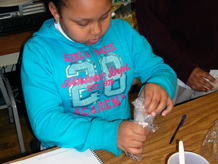What happens to shells when we crush them?
2. Predict what will happen

Distribute a tray of materials to each group, and then hold up a bag of shells.
- Think about this bag of shells as they are right now, before they are crushed. If we keep them in this bag and crush them by stepping on them, what do you predict will change and what will stay the same?
Give students a few minutes to record their predictions in their science notebooks [What changes and what stays the same when we crush shells?]. Make sure students explain the reasoning behind each prediction: Why do they think what they think?
After the students have finished recording their predictions, ask them to share their ideas in their small groups. What properties of the shells are they thinking about? Many students will think of color, size, and shape. Others may mention weight and volume. Some may think of smell, texture, or luster.
As you circulate among the groups, take note of what students predict will change and what they predict will stay the same.
- How can you check your predictions? What kind of data would you need to collect?
Bring the ideas together in a list of the students' predictions. Make sure weight and volume are on the list, and that each prediction has a corresponding idea for how to test it, as in the chart below.
| Some likely student predictions | How to check predictions |
|---|---|
| The weight will [or will not] change. | Weigh shells before and after crushing. |
| The sizes of the pieces will change. | Trace one shell before crushing the bag of shells. |
| The volume of the shells themselves will [or will not] change. | Measure shell volume before and after crushing. |
| The color will [or will not] change. | Save a sample of uncrushed shell for comparison. |
Tell students you’d like each team of students to check the weight and volume of the shells, along with two additional properties, then set them to work.



